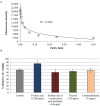In vitro Assessment of Antiviral Effect of Natural Compounds on Porcine Epidemic Diarrhea Coronavirus
- PMID: 33855058
- PMCID: PMC8039285
- DOI: 10.3389/fvets.2021.652000
In vitro Assessment of Antiviral Effect of Natural Compounds on Porcine Epidemic Diarrhea Coronavirus
Abstract
Organic acid and essential oils (EOs), well-known antimicrobials, could also possess antiviral activity, a characteristic which has not been completely addressed up to now. In this study, the effect of two organic acids (formic acid and sodium salt of coconut fatty acid distillates) and two single EO compounds (thymol and cinnamaldehye) was evaluated against porcine epidemic diarrhea virus (PEDV). The concentration used for each compound was established by cytotoxicity assays in Vero cells. The antiviral activity was then evaluated at three multiplicities of infection (MOIs) through visual cytopathic effect (CPE) evaluation and an alamarBlue assay as well as real-time reverse-transcription PCR (RT-qPCR) and viral titration of cell supernatants. Formic acid at at a dose of 1,200 ppm was the only compound which showed antiviral activity, with a weak reduction of CPE caused by PEDV. Through the alamarBlue fluorescence assay, we showed a significant anti-CPE effect of formic acid which could not be observed by using an inverted optical microscope. RT-qPCR and infectivity analysis also showed that formic acid significantly reduced viral RNA and viral titers in a PEDV MOI-dependent manner. Our results suggest that the antiviral activity of formic acid could be associated to its inhibitory effect on viral replication. Further studies are required to explore the anti-PEDV activity of formic acid under field conditions alone or together with other antiviral agents.
Keywords: antiviral activity; cytopathic effect; organic acids; pig; single essential oil compounds.
Copyright © 2021 Gómez-García, Puente, Argüello, Mencía-Ares, Rubio and Carvajal.
Conflict of interest statement
The authors declare that the research was conducted in the absence of any commercial or financial relationships that could be construed as a potential conflict of interest.
Figures





References
-
- Gómez-García M, Argüello H, Puente H, Mencía-Ares Ó, González S, Miranda R, et al. . In-depth in vitro evaluation of the activity and mechanisms of action of organic acids and essential oils against swine enteropathogenic bacteria. Front Vet Sci. (2020) 7:572947. 10.3389/fvets.2020.572947 - DOI - PMC - PubMed
-
- Mencía-Ares O, Argüello H, Puente H, Gómez-García M, Álvarez-Ordóñez A, Manzanilla EG, Carvajal A, et al. . Effect of antimicrobial use and production system on Campylobacter spp., Staphylococcus spp. and Salmonella spp. resistance in Spanish swine: a cross-sectional study. Zoonoses Public Health. (2021) 68:54–66. 10.1111/zph.12790 - DOI - PubMed
LinkOut - more resources
Full Text Sources
Other Literature Sources
Research Materials
Miscellaneous

